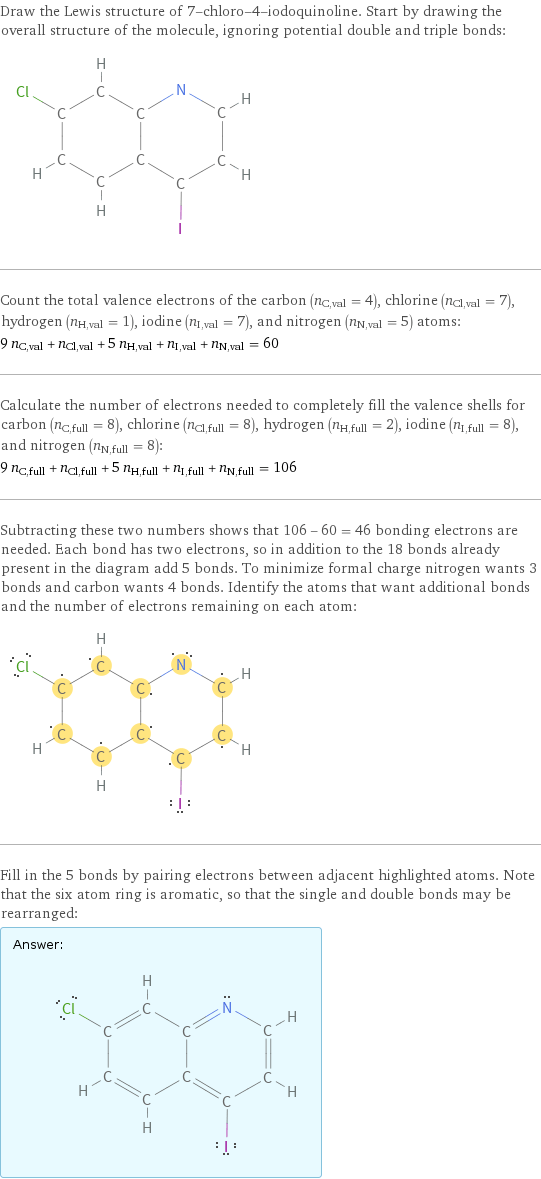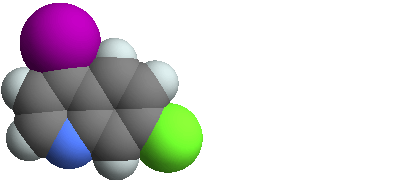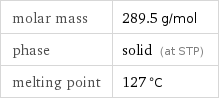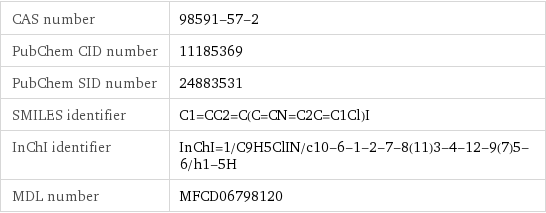Input interpretation

7-chloro-4-iodoquinoline
Chemical names and formulas

formula | C_9H_5ClIN name | 7-chloro-4-iodoquinoline alternate names | 7-chloro-4-iodo-quinoline mass fractions | C (carbon) 37.3% | Cl (chlorine) 12.2% | H (hydrogen) 1.74% | I (iodine) 43.8% | N (nitrogen) 4.84%
Lewis structure

Draw the Lewis structure of 7-chloro-4-iodoquinoline. Start by drawing the overall structure of the molecule, ignoring potential double and triple bonds: Count the total valence electrons of the carbon (n_C, val = 4), chlorine (n_Cl, val = 7), hydrogen (n_H, val = 1), iodine (n_I, val = 7), and nitrogen (n_N, val = 5) atoms: 9 n_C, val + n_Cl, val + 5 n_H, val + n_I, val + n_N, val = 60 Calculate the number of electrons needed to completely fill the valence shells for carbon (n_C, full = 8), chlorine (n_Cl, full = 8), hydrogen (n_H, full = 2), iodine (n_I, full = 8), and nitrogen (n_N, full = 8): 9 n_C, full + n_Cl, full + 5 n_H, full + n_I, full + n_N, full = 106 Subtracting these two numbers shows that 106 - 60 = 46 bonding electrons are needed. Each bond has two electrons, so in addition to the 18 bonds already present in the diagram add 5 bonds. To minimize formal charge nitrogen wants 3 bonds and carbon wants 4 bonds. Identify the atoms that want additional bonds and the number of electrons remaining on each atom: Fill in the 5 bonds by pairing electrons between adjacent highlighted atoms. Note that the six atom ring is aromatic, so that the single and double bonds may be rearranged: Answer: | |
3D structure

3D structure
Basic properties

molar mass | 289.5 g/mol phase | solid (at STP) melting point | 127 °C
Units

Chemical identifiers

CAS number | 98591-57-2 PubChem CID number | 11185369 PubChem SID number | 24883531 SMILES identifier | C1=CC2=C(C=CN=C2C=C1Cl)I InChI identifier | InChI=1/C9H5ClIN/c10-6-1-2-7-8(11)3-4-12-9(7)5-6/h1-5H MDL number | MFCD06798120